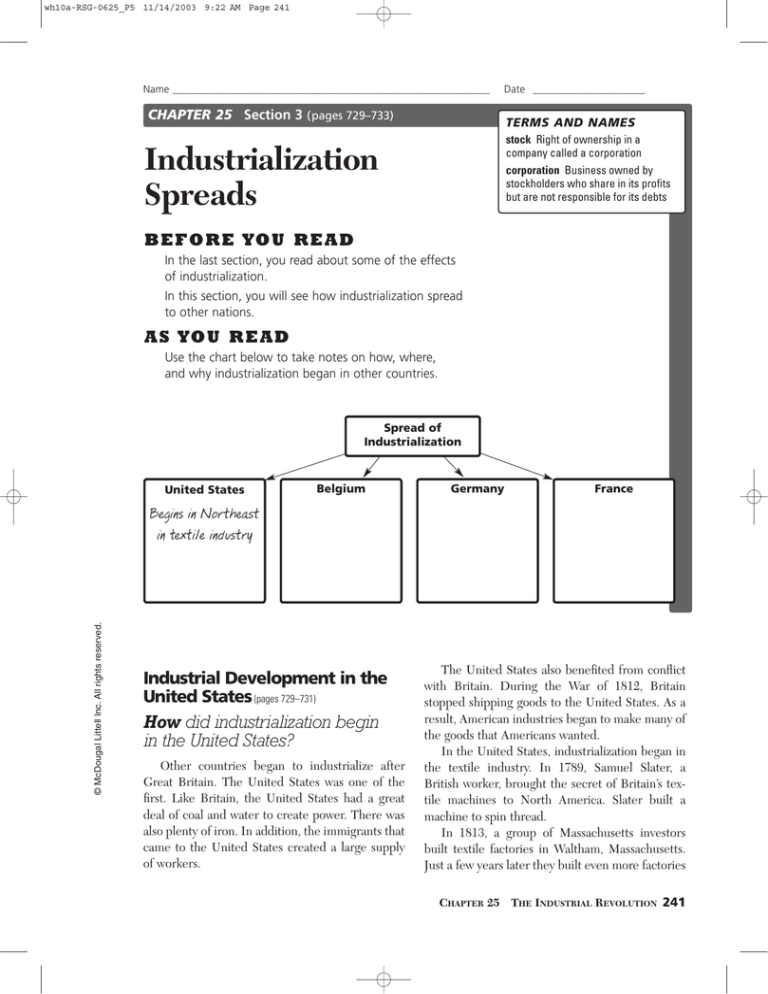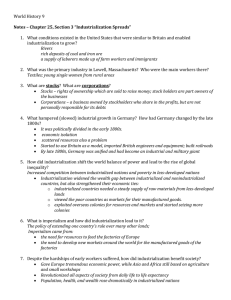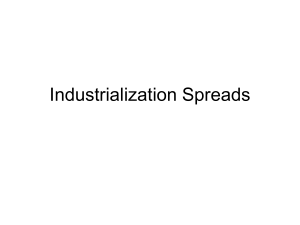
wh10a-RSG-0625_P5 11/14/2003 9:22 AM Page 241
Name ______________________________________________________________
Date ______________________
CHAPTER 25 Section 3 (pages 729–733)
TERMS AND NAMES
stock Right of ownership in a
company called a corporation
corporation Business owned by
stockholders who share in its profits
but are not responsible for its debts
Industrialization
Spreads
BEFORE YOU READ
In the last section, you read about some of the effects
of industrialization.
In this section, you will see how industrialization spread
to other nations.
AS YOU READ
Use the chart below to take notes on how, where,
and why industrialization began in other countries.
Spread of
Industrialization
United States
Belgium
Germany
France
Begins in Northeast
© McDougal Littell Inc. All rights reserved.
in textile industry
Industrial Development in the
United States (pages 729–731)
How did industrialization begin
in the United States?
Other countries began to industrialize after
Great Britain. The United States was one of the
first. Like Britain, the United States had a great
deal of coal and water to create power. There was
also plenty of iron. In addition, the immigrants that
came to the United States created a large supply
of workers.
The United States also benefited from conflict
with Britain. During the War of 1812, Britain
stopped shipping goods to the United States. As a
result, American industries began to make many of
the goods that Americans wanted.
In the United States, industrialization began in
the textile industry. In 1789, Samuel Slater, a
British worker, brought the secret of Britain’s textile machines to North America. Slater built a
machine to spin thread.
In 1813, a group of Massachusetts investors
built textile factories in Waltham, Massachusetts.
Just a few years later they built even more factories
CHAPTER 25 THE INDUSTRIAL REVOLUTION 241
wh10a-RSG-0625_P6 11/14/2003 9:22 AM Page 242
1. How did industrialization begin in the
United States?
Continental Europe
Industrializes (pages 731–732)
Where did industrialization begin
in Continental Europe?
Industrial growth also spread from England to the
European continent. Belgium was the first to
industrialize. It was rich in iron and coal and had
good waterways.
Germany was divided politically until the late
1800s. As a result, it did not develop much industry at first. However, the Ruhr Valley in Western
Germany was rich in coal. The Ruhr Valley eventually became a leading industrial region.
Across Europe, small areas began to change to
the new industries. Industrial growth did not occur
in France until after 1830. It was helped by the
242 CHAPTER 25 SECTION 3
government’s construction of a large network of
railroads. Some countries, such as Austria-Hungary
and Spain, faced transportation problems that held
them back from industrializing.
2. Which nations industrialized first, and why?
The Impact of Industrialization
(page 733)
How did industrialization change
the world?
The Industrial Revolution changed the world.
Countries that industrialized gained more wealth
and power than those that did not. The countries of
Europe soon began to take advantage of lands in
Africa and Asia.
The Europeans wanted to use these lands as
sources of raw materials for their factories.
European merchants saw the people on other continents as little more than markets for European
goods. The European nations took control of the
lands in many areas of the world outside of Europe.
This practice is called imperialism.
The Industrial Revolution that took place in the
1700s and 1800s changed life forever in the countries that industrialized. Problems caused by industrialization led to movements for social reform.
3. How did industrialization lead to imperialism?
© McDougal Littell Inc. All rights reserved.
in the Massachusetts town of Lowell. Thousands of
workers, mostly young girls, came to these towns to
work in the factories.
American industry first grew in the Northeast.
In the last decades of the 1800s, industrial growth
spread to other areas of the nation. This boom was
fueled by large supplies of coal, oil, and iron. New
inventions, including the electric light, also helped.
As in Britain, railroad building was also a big part
of American industrial growth.
Businesses needed huge sums of money to do
big projects. To raise money, companies sold stock.
Stocks are shares of ownership in a company. All
those who held stock were part owners of the company. This form of business organization is called a
corporation.






